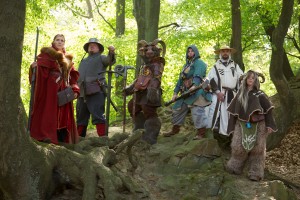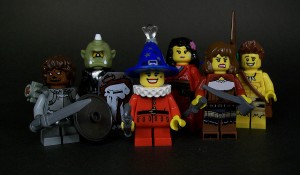We’ve already talked about how dynamic of a role the GM is for a game. Now it’s time to look at the other side of the table: the players. Players tend to be easier to find than GMs, but that doesn’t mean they don’t have a significant role in play experience. Without good people in these roles, there’s no game.
This is especially true when it comes to inventive character design. Many players build in depth backstories for their characters, with detailed accounts of their various trials and conflicts, friends and rivals, etc. Others may not do so detailed a backstory, but have a specific goal or mindset that is separate from (though often still compatible with) the main “goal” of a campaign. I once ran a Don’t Rest Your Head game (find it here, I highly recommend it) where one of the characters was an insomniac due to an uncomfortable bed. They helped their friends in the world of nightmares because they were a decent person, but were always on the lookout for a replacement mattress that would truly supply the rest that they so desperately needed. There wasn’t any information, but it was enough to start building up a solid character.
Anything along these lines can be a great inspiration to a GM having trouble coming up with personal touches for a campaign. And even pre-written campaigns benefit from this character depth. Flat characters result in cookie cutter games, because there’s

point where a boring character restricts a GMs ability to add anything interesting to interact with. Providing your own pieces of world building like that is an incredible clay for the GM to mold and use, and such details have often shaped entire campaign arcs. Each player is making the world of a game richer with their creations. While a GM frequently can only add details to a few of their many creations, the player has the ability to fully flesh out one individual. They embrace the world and with their depth, give it life.
Of course, this isn’t always seen as a positive thing. Players are essentially all actors in an improv show for an audience of each other, and nobody likes it when one person steals all the limelight. There is an equilibrium, where building an in depth character can cross from being a way to richen a game, to being a weight on the game, boring the players and frustrating the GM. The easy example is the “fallen heir,” where a player plays an exiled/orphaned/lost hair to some great throne or other position of power. Played well, this can flesh out an entire kingdom, and give a character a driving reason to adventure and better themselves. It becomes a problem when that player expects the entire campaign to revolve around them regaining their kingdom, or when they expect the other players to act as servants to that character. Of course there are exceptions to every rule, but a player must be able to read the field and tactfully decide when their character motivation is a fun part of play for the rest of the group, and when it isn’t. This is one of those “skills learned in-game” that also has some great real world benefits. The world would probably be a nicer place if everybody was more capable of reading the reactions of a room, and knowing when to keep talking and when to give somebody else a chance to speak.
It is also noteworthy that only players can be accused of stealing the spotlight (except in very extreme cases). The GM frequently talks more than any other player, and is involved in most of the players interactions, but is very rarely told that they are being an attention hog. Their roles are inherently different. The GM is invisible in some ways during play, like the word “said” in a piece of fiction. The only time the GM would be accused of this is in the case of an overpowered “GMpc,” a character that the GM controls that adventures with the players, but it much more skilled than them. This is considered stepping to far into the role of the player, and frequently GMs are critiqued if their characters take on too large of a role.
Players also have to think differently than a GM. GMs build traps, puzzles, and worlds for the players to inhabit, but usually this is done in advance. They may have to improvise things if they didn’t plan very well that week, but in general the GM has at least a slight running background knowledge of everything that is happening in the game world that the players inhabit. They build structures in advance and react to player actions. The players have no opportunity to plan in or explore the world before they are thrust into it. There’s no way to tell if killing the vampires will result in the town loving or hating you until you actually do it.
Players improvise in different ways, problem solving in a world where there actions are not limited by mechanics. Often game mechanics serve to distance players from lateral thinking (lateral thinking being traditional “outside the box” style problem solving). An easy example is this Professor Layton puzzle. It requires lateral thinking, but in a way that makes the puzzle solver feel cheated. A player has a base set of expectations set up by the game they are playing, and their brain won’t consider options outside of this. In many games, attacking enemies are highlighted with red or have health bars pop up. It’s understood that when that happens, the only option is to fight; the game literally will not allow for another course of action at that point. So when a game (video games are especially susceptible to this) seems to change rules and then blame the player for not being “creative enough,” it’s not a positive experience for the player.
Tabletop game puzzles don’t have this sort of inherent mechanics-based mental blocking. A player may be confined by their character’s abilities (their barbarian with a low Int score isn’t going to be able to read the spellbook), but they are allowed to try whatever they want, and the game mechanics don’t set up any mental blocks. The players always have the option to stop a fight and leave, or try to talk, etc. This allows for a much greater ability to learn lateral thinking patterns than is allowed by most video games (Note: I’m not saying tabletop games are inherently better, because both mediums have their strengths. Just that in this circumstance there’s more freedom of action). For more details on what I mean by games inherently controlling player actions, see the Stanley Parable “game”, which does a great deconstruction of original action and choice in video games.
Games in general are active mediums, much more so than the average book or movie (nothing I shout at the screen will make the ending change). Tabletop games specifically place an especially important role on the player. A video game needs interaction, but in the end, it is providing an experience for the player to absorb. The player consumes the game, and the game has no goal but to entertain the player. In a tabletop rpg, the players are of course playing for their own enjoyment, but also for the enjoyment of the other players. They are simultaneously producers and consumers of the game and each others’ labor. One unruly player can sour a game for some, while a team of on their game players can make memories that last decades.
Players have their own unique roles in a tabletop rpg that puts them in touch with their story like few other mediums can. They create living, breathing people, and interact with others with those people. A good group of players can make up for a lackluster GM, and one player taking over can ruin a game for everybody else. They are the lifeblood of a game session, and it’s important to think of how their abilities to influence the game differ from others involved in the process.

What are some character arcs you’ve been proud to witness? Do you ever notice times when the GM and the players work together on a part of the adventure to make it more interesting as a whole? Or how about some nightmare stories of players that just couldn’t fit properly in the game, why do you think that happens?